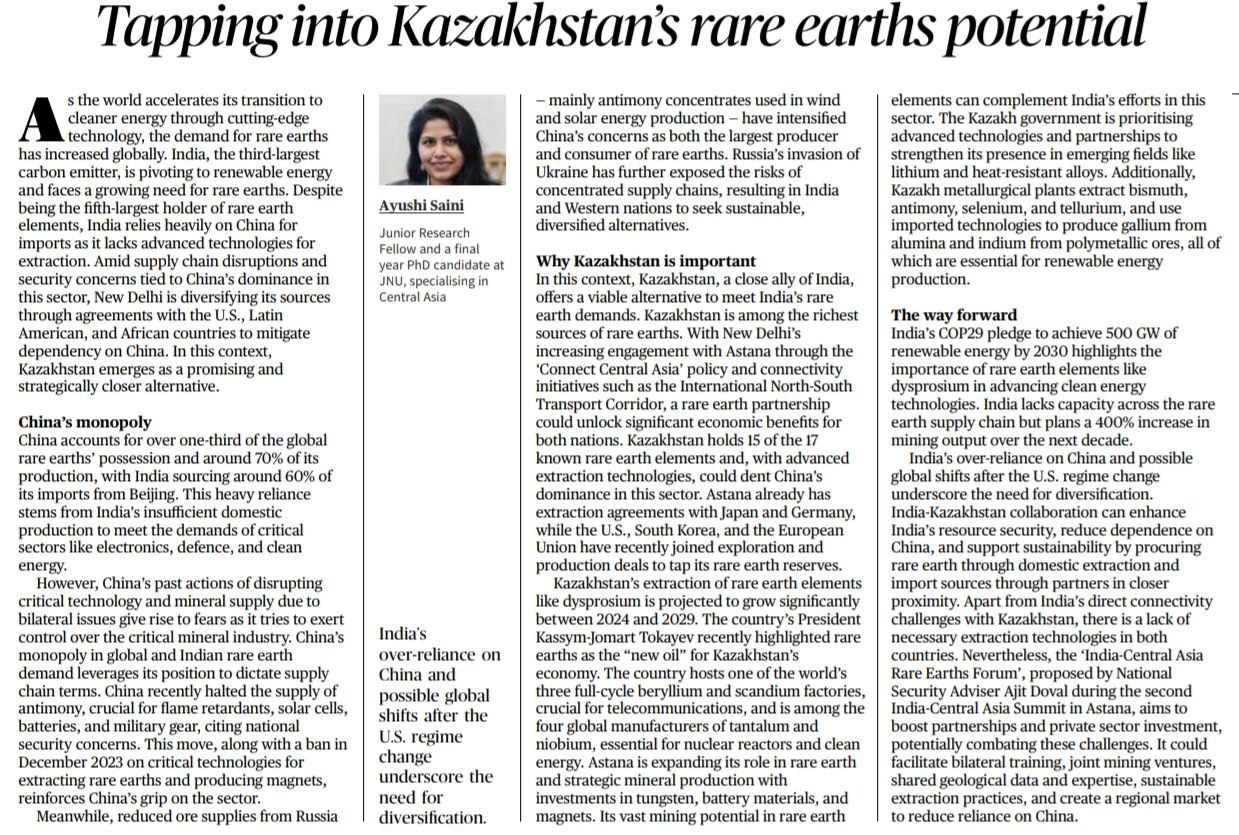India's Strategic Pursuit of Kazakhstan's Rare Earths Potential
Introduction
- Rare earth elements (REEs) are critical for advancing clean energy, electronics, and defense technologies.
- India is the third-largest carbon emitter and is heavily reliant on China for REE imports, facing challenges like supply disruptions and geopolitical risks.
- Kazakhstan, with its vast rare earth reserves and close ties with India, emerges as a viable alternative to diversify India’s supply chain.
China’s Monopoly on Rare Earths
- Dominance: Controls one-third of global REE reserves and 70% of production.
- India’s Reliance: Imports 60% of its REEs from China due to limited domestic extraction capabilities.
- Strategic Risks:
- Supply chain disruptions due to China’s geopolitical leverage.
- Recent Chinese bans on exports of critical REE technologies and materials (e.g., antimony and magnets).
Kazakhstan’s Significance
- Rich Reserves: Among the richest sources of REEs, including 15 of the 17 known elements.
- Strategic Partnerships:
- Aligns with India through initiatives like the International North-South Transport Corridor and the ‘India-Central Asia Rare Earths Forum.’
- Potential to reduce China’s dominance in the sector.
- Extraction and Production Growth: Projections show a 400% increase in Kazakhstan’s rare earth mining between 2024 and 2029.
Advantages for India
- Resource Security: Enhanced access to critical minerals like dysprosium and niobium.
- Industrial Applications: Kazakh metallurgical plants support REE-based applications for clean energy and high-tech sectors.
- Diversification: Strengthens India’s resilience against supply chain vulnerabilities.
Challenges
- Infrastructure Deficiencies: Limited extraction technologies in both nations.
- Connectivity Issues: Need for efficient logistics and supply chain mechanisms between India and Kazakhstan.
The Way Forward
- Policy Initiatives:
- India’s COP29 pledge to achieve 500 GW of renewable energy emphasizes the need for REEs.
- The proposed ‘India-Central Asia Rare Earths Forum’ to foster joint ventures and private investments.
- Collaboration:
- Expanding bilateral exploration, extraction, and production projects.
- Building regional networks to ensure sustainable access to REEs.
Conclusion
- Reducing over-reliance on China for REEs is imperative for India’s energy and technology security.
- Kazakhstan offers a strategic alternative due to its rich reserves and existing ties with India.
- By leveraging mutual cooperation, India can ensure a diversified and sustainable REE supply chain, crucial for achieving its renewable energy and technological aspirations.
Mains Practice Question |
Q. “India’s energy transition and technological advancements depend significantly on rare earth elements (REEs).” Discuss how India’s engagement with Kazakhstan could reduce its dependency on China for REEs and strengthen its resource security. |
2. Debating the Reintroduction of Wealth Tax in India
Introduction
- Recent discussions, inspired by economist Thomas Piketty, highlight the possibility of reintroducing wealth and inheritance taxes to reduce inequality and fund essential sectors like health and education.
- The debate centers on whether India should reinstate the wealth tax, which was abolished in 2016 due to inefficiencies in collection.
Arguments Against Reintroduction
- Measurement Challenges:
- Difficulty in accurately measuring wealth due to complexities in valuing assets like real estate, gold, and equities.
- Risk of incentivizing asset hoarding over productive investments.
- Economic Harm:
- Higher taxes could encourage fund outflows and discourage wealth generation.
- India’s progress could be hampered if policies disincentivize investments in productive assets.
- Ineffectiveness:
- The past collection from the wealth tax was minimal, constituting less than 0.1% of direct tax revenues.
Arguments for Reintroduction
- Tackling Inequality:
- A wealth tax could bridge the gap between the rich and poor, ensuring the super-rich contribute proportionally to social welfare.
- Existing systems, like Aadhaar and digital tax platforms, could facilitate efficient implementation.
- Funding Public Goods:
- Revenues from wealth tax could strengthen sectors like health and education, particularly in underfunded areas.
- Global Precedents:
- Wealth taxes exist in countries like the U.S. and U.K., addressing inequalities and redistributing resources.
Practical Considerations
- Data Issues:
- Lack of reliable data on wealth distribution makes enforcement challenging.
- Surveys and external rankings (e.g., Forbes) do not capture the complete picture.
- Thresholds and Rates:
- Identifying appropriate wealth thresholds for taxation is crucial to avoid targeting the middle class or small businesses.
- Sectoral Allocation:
- Revenues should be explicitly allocated to priority sectors to justify the imposition of the tax.
Alternative Solutions
- Inheritance Tax:
- Targeting intergenerational wealth transfer rather than annual wealth could be more effective.
- Property Tax Reform:
- Better implementation of property taxes could address inequality without introducing a new tax regime.
- Improved Fiscal Responsibility:
- Strengthening existing tax collection mechanisms and curbing corruption could achieve similar goals.
Conclusion
- The wealth tax debate reflects larger concerns about inequality and public finance in India.
- While reintroduction could address inequality and fund critical sectors, practical challenges such as data gaps, implementation inefficiencies, and potential economic disruptions must be addressed.
- A balanced approach, combining progressive taxes and robust public spending, is essential for sustainable development.
Mains Practice Question |
Q. “The reintroduction of the wealth tax in India is often debated as a means to reduce inequality and fund public goods. Critically examine the feasibility and implications of reintroducing the wealth tax in the Indian context.”
|



